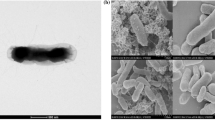Abstract
The use of sulfate-reducing bacteria (SRB) is a cost-effective route to treat sulfate- contaminated waters and precipitate metals. The isolation and characterization of a SRB strain from an AMD in a Brazilian tropical region site was carried out. With a moderately acidic pH (5.5), the C.1 strain began its growth and with continued growth, modified the pH accordingly. The strain under these conditions reduced sulfate at the same rate as an experiment performed using an initial pH of 7.0. The dsrB gene-based molecular approach was used for the characterization of this strain and its phylogenetic affiliation was similar to genus Desulfovibrio sp. The results show an SRB isolate with unexpected sulfate reducing capacity in moderately acidic conditions, bringing new possibilities for the treatment of AMD, as acid water would be neutralized to a mildly acidic condition.






Similar content being viewed by others
References
Cheng KH, Gu JD (2003) Reduction of chromate (CrO 2−4 ) by an enrichment consortium and an isolate of marine sulfate-reducing bacteria. Chemosphere 52:1523–1529
Cabrera G, Pérez R, Gómez JM, Ábalos A, Cantero D (2006) Toxic effects of dissolved heavy metals on Desulfovibrio vulgaris and Desulfovibrio sp. strains. J Hazard Mater 135:40–46
Dar SA, Stams AJM, Kuenen JG, Muyzer G (2007a) Co-existence of physiologically similar sulfate-reducing bacteria in a full-scale sulfidogenic bioreactor fed with a single organic electron donor. Appl Microbiol Biot 75(6):1463–1472
Dar SA, Yao L, Dongen UJ et al (2007b) Analysis of diversity and activity of sulfate reducing bacterial communities in sulfidogenic bioreactors using 16S rRNA and dsrB genes as molecular markers. Appl Environ Microbiol 73(2):594–604
Elliott P, Ragusa S, Catcheside D (1998) Growth of sulfate-reducing bacteria under acidic conditions in an upflow anaerobic bioreactor as a treatment system for acid mine drainage. Water Res 32:3724–3730
García C, Moreno DA, Ballester A, Blázquez ML, González F (2001) Bioremediation of an industrial acid mine water by metal-tolerant sulphate-reducing bacteria. Miner Eng 14(9):997–1008
Geets J, Borremans B, Diels L et al (2006) DsrB gene-based DGGE for community and diversity surveys of sulfate-reducing bacteria. J Microbiol Methods 66(2):194–205
Johnson DB (1998) Biodiversity and ecology of acidophilic microorganisms. FEMS Microbiol Ecol 27:307–317
Johnson DB, Sen AM, Kimura S, Rowe OF, Hallberg KB (2006) Novel biosulfidogenic system for selective recovery of metal from acidic leach liquors and streams. Miner Process Extr Metall 115(1):19–24
Joulian C, Ramsing NB, Ingvorsen K (2001) Congruent phylogenies of most common small-subunit rRNA and dissimilatory sulfite reductase gene sequences retrieved from estuarine sediments. Appl Environ Microbiol 67(7):3314–3318
Kaksonen AH, Franzmann PD, Purakka JA (2003) Performance and ethanol oxidation kinetics of a sulfate-reducing fluidized-bed reactor treating acidic metal-containing wastewater. Biodegradation 14:207–217
Kappler U, Dahl C (2001) Enzymology and molecular biology of prokaryotic sulfite oxidation. FEMS Microbiol 203:1–9
Kolmert A, Johnson DB (2001) Remedition of acidic waste water using immobilised, acidophilic sulfate-reducing bacteria. J Chem Technol Biotechnol 76:836–843
Leloup J, Quillet L, Berthe T, Petit F (2006) Diversity of the dsrAB (dissimilatory sulfite reductase) gene sequences retrieved from two contrasting mudflats of the Seine estuary, France. FEMS Microbiol Ecol 55:230–238
Loy A, Küsel K, Lehner A et al (2004) Microarray and functional gene analyses of sulfate-reducing prokaryotes in low-sulfate, acidic fens reveal cooccurrence of recognized genera and novel lineages. Appl Environ Microbiol 70(12):6998–7009
Medircio SN, Leão VA, Teixeira MC (2007) Specific growth rate of sulfate reducing bacteria in the presence of manganese and cadmium. J Hazard Mater 143:593–596
Mogensen GL, Kjeldsen KU, Ingvorsen K (2005) Desulfovibrio aerotolerans sp. nov., an oxygen tolerant sulphate-reducing bacterium isolated from activated sludge. Anaerobe 11:339–349
Ollivier B, Cord-Ruwisch R, Hatchikian EC, Garcia JL (1988) Characterization of Desulfovibrio fructosovorans sp. nov. Arch Microbiol 149:447–450
Ouattara AS, Patel BKC, Cayol JL et al. (1999) Isolation and characterization of Desulfovibrio burkinensis sp. nov. from an African ricefield, and phylogeny of Desulfovibrio alcoholivorans. Int J Syst Bacteriol 49:639–643
Pérez-Jiménez JR, Young LY, Kerkhof LJ (2001) Molecular characterization of sulfate-reducing bacteria in anaerobic hydrocarbon-degrading consortia ad pure cultures using the dissimilatory sulfite reductase (dsr AB) genes. FEMS Microbiol Ecol 35:145–150
Sambrook J, Fritsch EF, Maniatis T (1989) Molecular cloning—a laboratory manual, 2nd edn. Cold Spring Habour Laboratory Press, New York
Thompson JD, Gibson TJ, Plewniak F, Jeanmougin F, Higgins DG (1997) The clustalX windows interface: flexible strategies for multiple sequence alignment aided by quality analysis tools. Nucleic Acids Res 25:4876–4882
Tsukamoto TK, Killion HA, Miller GC (2004) Column experiments for microbiological treatment of acid mine drainage: low-temperature, low-pH and matrix investigations. Water Res 38:1405–1418
Wagner M, Roger AJ, Brusseau GA, Stahl DA (1998) Phylogeny of dissimilatory sulfite reductase supports an early origin of sulfate respiration. J Bacteriol 180:2975–2982
Zverlov V, Klein M, Lücker S et al (2005) Lateral gene transfer of dissimilatory (bi)sulfite reductase revisited. J Bacteriol 187(6):2203–2208
Acknowledgements
The financial support for this work from “FINANCIADORA DE ESTUDOS E PROJETOS—FINEP” is gratefully appreciated. The “Universidade Federal de Ouro Preto” scholarship to L. R. Rampinelli is also acknowledged.
Author information
Authors and Affiliations
Corresponding author
Rights and permissions
About this article
Cite this article
Rampinelli, L.R., Azevedo, R.D., Teixeira, M.C. et al. A sulfate-reducing bacterium with unusual growing capacity in moderately acidic conditions. Biodegradation 19, 613–619 (2008). https://doi.org/10.1007/s10532-007-9166-y
Received:
Accepted:
Published:
Issue Date:
DOI: https://doi.org/10.1007/s10532-007-9166-y




